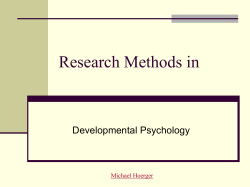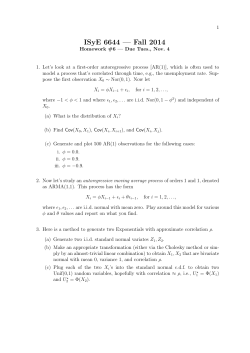
RESEARCH METHODS IN I/O PSYCHOLOGY
RESEARCH METHODS IN I/O PSYCHOLOGY Goals of Science • Description • Prediction • Explanation The Empirical Research Cycle Research process - summarized as 5–step sequence Statement of the problem Design of research study Measurement of variables Analysis of data Conclusions from research STATEMENT OF THE PROBLEM Statement of the problem Theory Design of research study - Inductive method - Deductive method Measurement of variables Analysis of data Conclusions from research STATEMENT OF THE PROBLEM Statement of the problem Hypothesis Statement: It is difficult for individuals in dual-career families to experience WF balance. Example: Research Question: How can individuals in dualcareer families experience WF balance? Hypothesis: Dual-career individuals who have family and organizational support are more likely to experience WF balance compared to dual-career individuals with no family and organizational support. RESEARCH DESIGN Statement of the problem Design of research study Measurement of variables Analysis of data Conclusions from research Plan of Study - Internal & External Validity - Naturalness of Setting - Degree of Control Primary Research Methods - Laboratory Experiment - Quasi Experiment - Questionnaire - Observation - Qualitative Secondary Research Plan of Study: Internal Validity The extent to which we can infer that a relationship between two variables is causal or that absence of a relationship implies absence of cause. The extent to which observed relationship obtained from research design/study is real or artifactual. Plan of Study: External Validity The extent to which the findings from a research study are relevant to individuals and settings beyond those specifically examined in the study. The extent to which observed relationship obtained from research design/study are “generalizable”. Plan of Study: Naturalness of Research Setting Lab - "artificiality" - contrived and artificial - controlled or Field -"naturalness" - typically employs a real–life setting Plan of Study: Degree of Control • Confounding and extraneous variables • Manipulation—this is reflective of a high degree of control • Research designs that permit manipulation are technically referred to as "experiments" Primary Research There are 5 categories of types of Primary Research: Laboratory (experimental) Quasi-experimental Questionnaire Observation Qualitative Primary Research: Experimental Research Experiment • Investigator manipulates a variable under carefully controlled conditions and observes whether changes occur in a second variable • Used to detect cause-and-effect relationships Conditions that make a true experiment • Manipulation of independent variables • Random assignment into experimental conditions (experimental conditions & control) Primary Research: Experimental and Control Groups Experimental group •Subjects who receive some special treatment in regard to the independent variable Control group •Subjects who do not receive the special treatment given to the experimental group LOGIC: If the 2 groups are identical except for the variation created by the manipulation of IV, then any differences between groups must be due to manipulation of the IV Example of Experimental Design Sample Control Experimental Measure DV Advantages and Disadvantages of Experimental Research + permit cause-and-effect conclusions - lab experiments tend to be artificial - cannot be used to explore some research questions Primary Research Field Experiments: Quasi-Experiments •Participants must be and are selected for different conditions from pre–existing groups •Levels of the IV are/may be selected from pre–existing values and not created through manipulation by the researcher •Unlike true experimental designs where participants are randomly assigned to experimental and control groups, with quasi– experimental designs they are NOT •Quasi–experiments DO NOT permit the researcher to control the assignment of participants to conditions or groups Quasi-Experimental Example Greenberg: Employee Theft and Underpayment Inequity Greenberg: Employee Theft and Underpayment Inequity Pay deduction • • • Expressed inequity (Employment theft) Theft is a mechanism for redressing states of inequity Adequate explanations can lessen feelings of inequity This is “dose-responsive”: magnitude of the expressed inequity, rate of theft Greenberg: Employee Theft and Underpayment Inequity Plant 1 Plant 2 Plant 3 Control Condition 1 Condition 2 No cut in pay Inadequate explanation Adequate explanation DV Employee theft Greenberg: Employee Theft and Underpayment Inequity Time 1 End Plant A 64 55 Plant B 53 30 Measurement 1. Actuarial data on employee theft 2. Plant C 66 58 Self-reported measures Control •Randomly selected treatment for A and B, C as control •Assumed/proved homogeneity among subjects in different plants •Same characteristics among those who dropped out. •Treatment was received the same by all workers in a plant. Greenberg: Employee Theft and Underpayment Inequity 9 Mean Percentage of Employment Theft 8 7 Ina d e q ua te e xp la na tio n 6 5 4 A d e q ua te e xp la na tio n 3 C o ntro l 2 1 0 B e fo re D u rin g A ft e r T im e P e rio d R e la tiv e to P a y C u t Primary Research: Naturalistic Observation Careful, usually prolonged, observation of behavior without intervening directly with the subjects • No manipulation by researcher • No random assignment Often referred to as ex post facto designs Primary Research: Survey Research Measurement and assessment of opinions, attitudes, and other descriptive phenomenon usually by means of questionnaires and sampling methods • Popular method of research for I/O psychologists • Limitations include return rate • Web-based survey Primary Research: Qualitative A class of research methods in which the investigator takes an active role in interacting with the subjects he or she wishes to study • Interview/focus group • Ethnography: a research method that utilizes field observation to study a society’s culture. • Emic versus Etic - Emic: an approach to researching phenomena that emphasizes knowledge derived from the participants’ understanding of their own culture. - Etic: An approach to researching phenomena that emphasizes knowledge derived from the perspective of an objective investigator in understanding a culture. Primary Research: Summary Laboratory (experimental) Quasi-experimental Questionnaire Observation Qualitative Issues: Obtaining access to samples Common method bias Choosing the correct design to answer the research question. Secondary Research Methods A class of research methods that examines existing information from research Meta-analysis – statistical procedure designed to combine the results of many individual, independently conducted empirical studies into a single result or outcome Differences in studies could be due to statistical artifacts. Issues: - File draw effect - Subjective nature of research Measurement of Variables Statement of the problem Design of research study Measurement of variables Analysis of data Conclusions from research Types of Measurement Level of Measurement Characteristic Measurement of Variables: Types of Variables Variable: Some property of an object, phenomenon, or event whose measurement can take on two or more values • Independent/dependent • Predictor/criterion • Continuous/discrete • Qualitative/quantitative Measurement of Variables: Types of Variables What is the DV and what is the IV? In a study of the effects of different types of legal arguments on jurors’ perceptions of the guilt or innocence of a defendant, subjects were randomly assigned to hear an argument which related to their daily experiences or to an argument of a more abstract and idealistic nature. After listening to one of these legal arguments, subjects were asked to rate the guilt or innocence of the defendant on a twelvepoint scale. Measurement of Variables: Levels of Measurement A scale is a measuring device used to assess a person's score or status on a variable The four basic types of scales are: Nominal scales Ordinal scales Interval scales Ratio scales Measurement of Variables: Levels of Measurement Nominal Scale: 1=Single 2=Married 1 2 3 Ordinal Scale Not Satisfied Satisfied Very Satisfied 65 66 67 68 69 70 71 72 73 74 75 76 77 78 79 Interval Scale Degrees Fahrenheit 0 1 2 3 4 5 6 7 8 9 10 11 12 13 14 Ratio Scale Weight in pounds Measurement of Variables: Characteristics of Good Measurement Good test or measurement system should be: - reliable - valid - objective - standardized STATISTICAL ANALYSES OF DATA Statement of the problem Design of research study Measurement of variables Analysis of data Conclusions from research Purpose Distributions and Their Shape Measures of Central Tendency Measures of Variability Correlation Statistical Analysis: Purpose Statistical tests are procedures that are used to: - describe data - analyze relationships between variables (i.e., make inferences) Statistical Analysis: Distributions and Their Shape 3.5 3 2.5 2 1.5 1 0.5 0 -3SD -2SD -1 SD Mean 68% 95% 99% +1 SD +2 SD +3 SD Statistical Analysis: Measures of Central Tendency - Mean - Median - Mode Statistical Analysis: Measures of Central Tendency 12, 15, 10, 10, 9, 5, 10, 8, 12, 6, 7 12, 15, 10, 10, 9, 5, 10, 1, 8, 12, 6, 7 Statistical Analysis: Measures of Variability - Variability - Range - Standard Deviation Statistical Analysis: The Concept of Correlation Permit investigators to see whether there is a link or association between the variables of interest. Does not permit cause-and-effect conclusions. Statistical Analysis: The Concept of Correlation A correlation exists when two variables are related to one another. Two aspects of a correlation coefficient: Direction: Positive or negative Strength: Range of coefficients is from 1.00 to +1.00 Statistical Analysis: Positive Correlation high school GPA college GPA Statistical Analysis: Negative Correlation age hair on head Statistical Analysis: Positive Correlation Cognitive ability Job performance Statistical Analysis: Negative Correlation Role ambiguity Job satisfaction Statistical Analysis (11 and 21) Statistical Analysis Statistical Analysis (5’6” and 189lbs) 210 Weight 170 130 90 60 65 70 Height 75 Shoe size Statistical Analysis 14.50 12.50 10.50 8.50 6.50 4.50 2.40 2.90 3.40 GPA 3.90 4.40 Statistical Analysis: Interpreting a Correlation • Correlation and prediction • Correlation and causation • X may cause Y • Y may cause X • Z causes both X and Y Statistical Analysis: Summary of Correlation coefficients • The degree of linear relationship (association) between 2 variables •r • -1.0 to +1.0 • Correlation does not mean causality • Causality determined through laboratory or statistical control • Statistical vs. practical significance Statistical Analysis: Correlation coefficients examples Bond, F. W., Bunce, D. (2003). The Role of Acceptance and Job Control in Mental Health, Job Satisfaction, and Work Performance. Journal of Applied Psychology, 88, 1057-1067. Statistical Analysis: Correlation coefficients examples Barling, J., Kelloway, K. E., Iverson, R. D. (2003). High-quality work, job satisfaction, and occupational injuries. Journal of Applied Psychology, 88, 276-283. Conclusions • Theoretical and applied implications Statement of the problem • Limitations Design of research study • Generalizability Measurement of variables • Size and representativeness of sample Analysis of data Conclusions from research • Research method & protocol • Suggestions for future research Ethics in Research: What is Ethical Research? • Do not always know effects ahead of time Participant Cost Gains to Field • Ethical guidelines change over time Ethics in Research: What is Ethical Research? Ethically based research is concerned about the welfare of the research participant, maintaining honesty in conducting and reporting scientific research, giving appropriate credit for ideas and effort and considering how knowledge gained through research should be used. There are no clear “right” or “wrong’ answers. Treating research participants ethically matters not only for the welfare of the individuals themselves but also for the continued effectiveness of behavioral science as a scientific discipline Ethics in Research: Protecting Participants Type of Threats - Past research: e.g., Milgram studies - Participants may be told they failed an IQ or social skills test - Participant may learn something negative about themselves (tendency to stereotype others or they make unwise decisions) - Participants may perform behavior they are later embarrassed about The Potential for Lasting Impact Ethics in Research: Providing Freedom of Choice Conducting research outside the laboratory - Participant may not know research is happening - Institutions Securing Informed Consent Weighing informed consent versus the research goals Ethics in Research: Power Differentials Avoiding Abuses of Power Respecting Participants’ Privacy - anonymous vs. confidential Ethics in Research: Describing Research Deception: occurs whenever research participants are not completely and fully informed about the nature of the research project before participating in it. - Active vs. Passive - When Deception is necessary - Simulation studies - Consequences - Debriefing Ethics in Research: Ensuring Research is Ethical Department of Health and Human services has developed regulations for the protection of both animal and human research participants. - require all universities set up institutional review board (IRB) to determine whether proposed research meets regulations - researchers submit a written application to IRB requesting permission to conduct research - researchers have to describe potential risks and benefits. Researcher's Own Ethics Research in Summary Statement of the problem Design of research study Measurement of variables Analysis of data Conclusions from research Each stage should be conducted in an ethical and scientific manner Research in Industry • Distinguishing Features – – – – Arise from organizational problems Use of results Motives Science-practice divide
© Copyright 2025











